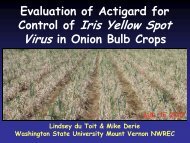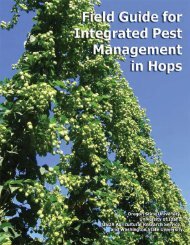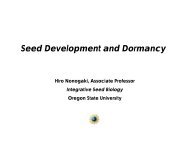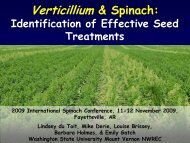Spinach Seed Production - WSU Integrated Pest Management ...
Spinach Seed Production - WSU Integrated Pest Management ...
Spinach Seed Production - WSU Integrated Pest Management ...
You also want an ePaper? Increase the reach of your titles
YUMPU automatically turns print PDFs into web optimized ePapers that Google loves.
<strong>Spinach</strong> <strong>Seed</strong> <strong>Production</strong><br />
(in the Pacific Northwest)<br />
2009 Teddy E. Morelock International <strong>Spinach</strong> Conference,<br />
Fayetteville, Arkansas<br />
Lindsey du Toit, Washington State University Mount Vernon NWREC
<strong>Spinach</strong> seed production
Global spinach seed production<br />
Country<br />
Estimated hectares<br />
(~2008)<br />
Denmark 6,500<br />
USA (OR, WA) 1,200<br />
Holland 500<br />
Italy 250<br />
France 220<br />
New Zealand 100<br />
Chile 20<br />
China (Asian markets)<br />
LOTS! (S. oleracea &<br />
Tetragonia spp.)
1 ha hybrid<br />
spinach<br />
seed crop<br />
~10 ha baby<br />
leaf spinach<br />
crop
<strong>Spinach</strong> <strong>Seed</strong> <strong>Production</strong> in Washington State
Crop Profile for <strong>Spinach</strong> <strong>Seed</strong> Crops in Washington State<br />
http://www.ipmcenters.org/cropprofiles/docs/waspinachseed.html<br />
Principles & Practices of Organic <strong>Spinach</strong> <strong>Seed</strong> <strong>Production</strong><br />
in the Pacific Northwest. Organic <strong>Seed</strong> Alliance.<br />
www.seedalliance.org
<strong>Seed</strong> crop<br />
isolation
Criteria for the spinach seed<br />
industry<br />
• trueness-to-type (genetically)<br />
• seed germination<br />
• seed vigor<br />
• pathogen-free seed<br />
• no weed seed/debris<br />
• cost of production – US$, labor<br />
• resistance to races of downy mildew
Grower expenses/returns<br />
• contract only, company dependent<br />
• expenses:<br />
WA: ~$1,400-$1,600/acre<br />
OR: higher (irrigation needed)<br />
• seed production costs increased 4x<br />
• price of competing crops<br />
• growers paid: $1.80-$2.00/lb seed<br />
• yields variable based on parent lines<br />
- earlier bolting lines ~ in DK & US<br />
- later bolting lines US < DK
Photo courtesy of Margaret Savage, ACSC<br />
Open-pollinated stock seed production
Photo courtesy of<br />
Margaret Savage, ACSC<br />
• First spinach hybrid: 1955, Topcross, USDA semi-savoy<br />
• High female lines: late 1960s/early ‘70s – monoecious<br />
• Female plants revert in absence of adequate pollen<br />
• Hermaphrodites: male & female flowers on same plant
Photos courtesy of<br />
Margaret Savage,<br />
ACSC<br />
<strong>Spinach</strong> breeding<br />
Pistillate (female)<br />
Monoecious male
Onodera et al. 2008. Scientia Horticulturae 118:266-269. (Fig. 1)<br />
Staminate flowers<br />
Pistillate flowers<br />
Pistillate &<br />
staminate flowers<br />
Pistillate &<br />
hermaphroditic
Photo courtesy of M. Savage, ACSC<br />
<strong>Spinach</strong> breeding
March-April<br />
Plow, mulch, fertilize; then limestone applied/incorporated<br />
RoNeet (cycloate) herbicide applied/incorporated
mid-May: Planting, in-furrow fertilizer, granular insecticide
Planting spinach stock seed<br />
• Treated seed:<br />
• thiram, mefenoxam, now thiophanate-methyl<br />
• Insecticide in-furrow for craneflies, springtails<br />
• carbofuran (Furadan)<br />
• Ratio of male:female rows<br />
• Staggered planting of male rows<br />
• Stock seed priming<br />
• cold imbibing<br />
• change daylength response time<br />
• correct nicking of male & females<br />
• reduce % inbred seed<br />
• cannot store seed > 3 months
Cultivate<br />
Spinaid<br />
(phenmedipam)<br />
at 2-4 true leaf<br />
stage<br />
Other<br />
herbicides:<br />
Nortron<br />
(ethofumesate)<br />
Dual Magnum<br />
(S-metolachlor)<br />
Fusilade<br />
(fluazifop-Pbutyl)<br />
Asulox<br />
(asulam)<br />
Cultivate, side-dress (27-0-0) or top-dress (CaNO 3 )
Application of a pesticide to a crop or site that<br />
is not on the label is a violation of pesticide law<br />
and may subject the applicator to civil penalties<br />
up to $7,500.<br />
In addition, such an application may also result<br />
in illegal residues that could subject the crop to<br />
seizure or embargo action by WSDA and/or the<br />
U.S. Food and Drug Administration.<br />
It is your responsibility to check the label<br />
before using the product to ensure lawful use<br />
and obtain all necessary permits in advance.
Rogue off-types & males in female rows: 3-7x/crop<br />
Fungicide applications: leaf spots, downy mildew;<br />
early anthesis, preceding rains
Fusarium Wilt
Verticillium wilt
Leaf spot fungi<br />
Photo by M.L. Derie<br />
Cladosporium<br />
variabile<br />
Stemphylium<br />
botryosum
Overwintering of spinach leaf spot fungi<br />
(du Toit & Derie, 2003. Phytopathology 93:S22)<br />
Cladosporium variabile on<br />
volunteer spinach<br />
Stemphylium botryosum on<br />
surface stem residues
Downy mildew
Cucumber mosaic virus<br />
Influence of parent line on<br />
rate of seed transmission<br />
du Toit et al., 2007. Phytopathology 97:S30
<strong>Integrated</strong> disease management<br />
• Rotation – long intervals:<br />
• for Fusarium wilt, Verticillium wilt<br />
• resistance of parent lines in previous crops<br />
• biofumigant cover crops or amendments<br />
• Clean stock seed:<br />
• assay for fungi & CMV, seed treatment combinations<br />
• Susceptibility of parent lines<br />
• Orientation of rows<br />
• Limestone: 1-2 tons/acre (pH 6.5+)<br />
• Fertilizers: nitrate vs. ammonium Zn Foliar feeds<br />
• Fungicides: timing (anthesis & rains), modes of action,<br />
organic & conventional<br />
• Scouting & roguing<br />
• Accurate diagnoses<br />
• <strong>Management</strong> of crop residues & volunteers
Aphids (vector viruses)
Root aphids Leafminer Thrips Lygus bugs<br />
Others: cranefly, cutworm, armyworm, looper
Windrowing
Diquat herbicide spray to combine without windrowing<br />
Photo courtesy of Jensen <strong>Seed</strong>s
Photos courtesy of Birte Boelt, DK
Photos courtesy of Jensen <strong>Seed</strong>s
Gravity table & sizer<br />
Photos courtesy<br />
of Jensen <strong>Seed</strong>s<br />
Gravity table
Photos courtesy of Jensen <strong>Seed</strong>s<br />
Spiral separator<br />
Color sorter
AOSA blotter seed<br />
germination assay<br />
<strong>Seed</strong> health assays
Acknowledgements<br />
Teddy Morelock, Univ. Arkansas; Paul Klein, Rijk Zwaan; Jay<br />
Schafer, SAS; Margaret Savage, ACSC;<br />
Henning van Veldhuizen, Jensen <strong>Seed</strong>s; Jan de Visser, Pop Vriend<br />
<strong>Seed</strong>s; Puget Sound <strong>Seed</strong> Growers’ Assoc., WWSAC














